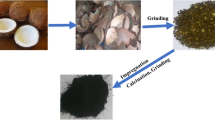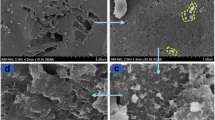Abstract
An activated carbon from Coconut (Cocos nucifera) shells was prepared by physical activation with carbon dioxide and water vapor. The activated carbon obtained has a surface area of 1058 m2 g−1 and such a high micropore volume of 0.49 cm3 g−1. This carbon was studied for the removal of lead from water. Sorption studies were performed at 30 °C, at different pH and adsorbent doses, in batch mode. Lead precipitation was observed on the surface of the activated carbon. Maximum adsorption occurred at pH 9 for an adsorbent dose of 2 g L−1. Kinetic studies, at the initial concentration of 150 mg L−1 of lead, pH 5 and an adsorbent dose of 1 g L−1, yielded an equilibrium time of 50 h for this activated carbon. The kinetic data were modeled with the pseudo first order, the pseudo second order and the Bangham models. The pseudo second order model fitted the data well. The sorption rate constant (7 × 10−4 mol−1 Kg s−1) and the maximum amount of lead adsorbed (0.23 mol kg−1) are quite good compared to the data found in literature. Sorption equilibrium studies were conducted in a concentration range of lead from 0 to 150 mg L−1. In an aqueous lead solution with an initial concentration of 30 mg L−1, at pH 5, adsorbent dose 1 g L−1, activated Coconut shell carbon removed at equilibrium 100 % of the heavy metal. The equilibrium data were modeled with the Langmuir and Freundlich equations, of which the former gave the best fit. The Langmuir constants Qmax eq (0.23 mol kg−1) and KL (487667 L mol−1) are in good agreement with literature. XPS studies identified adsorbed species as lead carbonates and/or lead oxalates and precipitates as lead oxide and/or lead hydroxide on the activated carbon surface. The Coconut shell activated carbon is a very efficient carbon due to its high surface area, to the presence of many micropores on its surface and to the presence surface groups like hydroxyls promoting adsorption in the porous system and lead crystal precipitation on the activated carbon surface.








Similar content being viewed by others
References
Ahmedna, M., Marshall, W.E., Husseiny, A.A., Rao, R.M., Goktepe, I.: The use of nutshell carbons in drinking water filters for removal of trace metals. Water Res. 38, 1062–1068 (2004)
Ajmal, M., Hussain Khan, A.: Role of sandwust in the removal of copper (II) from industrial wastes. Water Res. 32(10), 3085–3091 (1998)
Apac, R., Tutem, E., Hugul, M., Hizal, J.: Heavy metal cation retention by unconventional sorbents (red mud and fly ashes). Water Res. 32(2), 430–440 (1998)
Bansal, R.C., Donnet, J.B., Stoeckli, H.F.: Active Carbon. Marcel Dekker, New York (1988)
Boehm, H.P.: Some aspects of the surface chemistry of carbon blacks and other carbons. Carbon 32, 759–769 (1994)
Brunauer, S., Emmett, P.H., Teller, E.: Adsorption of gases in multimolecular layers. J. Am. Chem. Soc. 60, 309–319 (1938)
Burgess, J.: Metal Ions in Solution. Ellis Horwood, New York (1978)
Dimitrova, S.V.: Metal sorption on blast furnace slag. Water Res. 30(1), 228–232 (1996)
Dubinin, M.M.: The potential theory of adsorption of gases and vapors for adsorbents with energetically nonuniform surfaces. Chem. Rev. 60(2), 235–241 (1960)
Ferro-Garcia, M., Rivera-Utrilla, A., Bautista-Toledo, J.: Removal of lead from water by activated carbons. Carbon 28, 545–552 (1990)
Freundlich, H., Helle, W.J.: Ubber die adsorption in lusungen. J. Am. Chem. Soc. 61, 2–28 (1939)
Gharaibeh, S.H., Abu-El-Sha’r, W.Y., Al-Kofahi, M.M.: Removal of selected heavy metals from aqueous solutions using processed solid residue of olive mill products. Water Res. 32(2), 498–502 (1998)
Giles, C.H., MacEwan, T.H., Nakhwa, S.H., Smith, D.: Studies in adsorption. Part XI. A system of classification of solution adsorption isotherms, and its use in diagnosis of adsorption mechanisms and in measurement of specific surface areas of solids. J. Chem. Soc. 10, 3973–3993 (1960)
Gomez-Serrana, V., Macias-Garcia, A., Espinosa-Mansilla, A., Valenzuela-Calahorro, C.: Adsorptionof mercury, cadmium and lead from aqueous solution on heat-treated and sulphurized activated carbon. Water Res. 32, 1–4 (1998)
Gregg, S.J., Sing, K.S.W.: Adsorption, Surface Area and Porosity. Academic Press, London (1982)
Ho, Y.S., McKay, G.: Pseudo second order model for sorption process. Process. Biochem. 34, 451–465 (1999)
Ho, Y.S., Wase, D.A.J., Foster, C.F.: Kinetic studies of competitive heavy metal adsorption by sphagnum moss peat. Environ. Technol. 17, 71–77 (1996)
Issabayeva, G., Aroua, M.K., Sulaiman, N.M.N.: Removal of lead from aqueous solutions on palm shell activated carbon. Bioresour. Technol. 97, 2350–2355 (2006)
Kadirvelu, K., Faur-Brasquet, C., Le Cloirec, P.: Removal of Cu(II), Pb(II) and Ni(II) by adsorption onto activated carbon cloths. Langmuir 16, 8404–8409 (2000)
Ko, Y.G., Choi, U.S.: Observation of metal ions adsorption on novel polymeric chelating fiber and activated carbon fiber. Sep. Purif. Technol. 57, 338–347 (2007)
Kobya, M., Demirbas, E., Senturk, E., Ince, M.: Adsorption of heavy metal ions from aqueous solutions by activated carbon prepared from apricot stone. Bioresour. Technol. 96, 1518–1521 (2005)
Lagergren, S.: Zur theorieDer Sogenannten adsorption geloster stoffe Kungliga Svenska Vetenskapsakademiens. Handlingar 24, 1–39 (1898)
Langmuir, I.: Adsorption of gases on glass, mica and platinum. J. Am. Chem. Soc. 40, 1361–1403 (1918)
Largitte, L., Gervelas, S., Tant, T., Dumesnil, P.C., Lodewyckx, P.: Influence of the surface properties of the Bois carré seeds activated carbon for the removal of lead from aqueous solutions. Eurasian Chem. Technol. J. 14(3), 201–210 (2012)
Lee, S.M., Davis, A.P.: Removal of cu(II) and cd(II) from aqueous solution by seafood processing waste sludge. Water Res. 35, 534–540 (2001)
Machida, M., Aikawa, M., Tatsumoto, H.: Prediction of simultaneous adsorption of Cu(II) and Pb(II) onto activated carbon by conventional Langmuir type equation. J. Hazard. Mater. 120, 271–275 (2005)
Madhava Rao, M., Chandra Rao, G.P., Seshaiah, K., Choudary, N.V., Wang, M.C.: Activated carbon from Ceiba pentandra hulls, an agricultural waste, as an adsorbent in the removal of lead and zinc from aqueous solutions. Waste Manag. 28, 849–858 (2008)
Maranon, E., Sastre, H.: Ion exchange equilibria of heavy metals onto chemically modified apple residues. Solv. Extr. Ion Exch. 9(3), 515–531 (1991)
Marcus, Y.: Thermodynamics of solvation of ions. Part 5—gibbs free energy of hydration at 298.15 K. J. Chem. Soc. Faraday Trans. 87(18), 2995–2999 (1991)
Mishra, P.C., Patel, R.K.: Removal of lead and zinc ions from water by low cost adsorbents. J. Hazard. Mater. 168, 319–325 (2009)
Mohan, D., Pittman Jr, C.U., Bricka, M., Smith, F., Yancey, B., Mohammad, J., Steele, P.H., Alexandre-Franco, M.F., Gomez Serrano, V., Gong, H.: Sorption of arsenic, cadmium, and lead by chars produced from fast pyrolysis of wood and bark during bio-oil production. J. Colloid Interface Sci. 310, 57–73 (2007)
Murugesan, G.S., Sathishkumar, M., Swaminathan, K.: Arsenic removal from groundwater by pretreated waste tea fungal biomass. Bioresour. Technol. 97, 483–487 (2006)
Netzer, A., Hughes, D.E.: Adsorption of copper, lead and cobalt by activated carbon. Water Res. 18, 927–933 (1984)
Nightingale, E.R.: Phenomenological theory of ion solution. Effective radii of hydrated cations. J. Phys. Chem. 63, 1381–1387 (1959)
Noh, J.S., Schwarz, J.A.: Effect of HNO3 treatment on the surface acidity of activated carbons. Carbon 28, 675–682 (1990)
Olivier, J.P.: Modeling physical adsorption on porous and nonporous solids using density functional theory. J. Porous Mater. 2, 9–17 (1995)
Orhan, Y., Buyukgungor, H.: The removal of heavy metals by using agricultural waste. Water Sci. Tech. 28(2), 247–255 (1993)
Said, O.M., Shalmor, M.B., Egila, J.N.: A note on the binding of nickel and copper ions by cellulose materials. Bioresour. Technol. 43, 63–65 (1992)
Sreejalekshmi, K.G., Anoop Krishnan, K., Anirudhan, T.S.: Adsorption of Pb(II) and Pb(II)-citric acid on sawdust activated carbon: Kinetic and equilibrium isotherm studies. J. Hazard. Mater. 161, 1506–1513 (2000)
Stavropoulos, G.G., Zabaniotou, A.A.: Production and characterization of activated carbons from olive-seed waste residue. Microporous Microporous Mater. 82, 79–85 (2005)
Ulmanu, M., Teodorescu, R., Anger, I., Neagu, E.: Contribution to the study of advanced removal of cadmium onto the diluted solution using adsorbent materials: optimum contact time determination. In: Proceedings of Chemistry and Chemical Engineering Conference, vol. I, Part 2, Bucharest, pp. 296–303 (1995)
Ulmanu, M., Segarceanu, T., Vasiliu, C., Anger, I.: Removal of copper from dilute aqueous solutions by adsorbent and ion exchange materials: ion exchange developments and applications. In: SCI Conference IEX_96, UK, pp. 51–159 (1996)
Vázquez, G., Calvo, M., Freire, M.S., González-Alvarez, J., Antorrena, G.: Chestnut shell as heavy metal adsorbent: optimization study of lead, copper and zinc cations removal. J. Hazard. Mater. 172, 1402–1414 (2009)
Author information
Authors and Affiliations
Corresponding author
Rights and permissions
About this article
Cite this article
Largitte, L., Gervelas, S., Tant, T. et al. Removal of lead from aqueous solutions by adsorption with surface precipitation. Adsorption 20, 689–700 (2014). https://doi.org/10.1007/s10450-014-9613-0
Received:
Revised:
Accepted:
Published:
Issue Date:
DOI: https://doi.org/10.1007/s10450-014-9613-0




